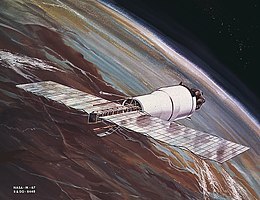 A Pegasus satellite in orbit | |
| Mission type | Micrometeoroid detection |
|---|---|
| Operator | NASA |
| COSPAR ID | 1965-009A |
| SATCAT no. | 001085 |
| Mission duration | 3 years 6 months 13 days |
| Spacecraft properties | |
| Spacecraft type | Pegasus |
| Manufacturer | Fairchild Hiller |
| Launch mass | 10,297 kilograms (22,701 lb) |
| Payload mass | 1,450 kilograms (3,200 lb) |
| Start of mission | |
| Launch date | 16 February 1965 |
| Rocket | Saturn I SA-9 |
| Launch site | Cape Canaveral LC-37B |
| End of mission | |
| Disposal | Decommissioned |
| Deactivated | 29 August 1968 |
| Decay date | 17 September 1978 |
| Orbital parameters | |
| Reference system | Geocentric |
| Regime | Low Earth orbit |
| Perigee altitude | 500 kilometers (270 nmi) |
| Apogee altitude | 731 kilometers (395 nmi) |
| Inclination | 31.7 degrees |
| Period | 97.00 minutes |
| Epoch | 18 March 1965 |
Apollo micrometeoroid investigation | |
Pegasus 1 or I, known before launch as Pegasus A, was an American satellite which was launched in 1965 to study micrometeoroid impacts in low Earth orbit. It was the first of three Pegasus satellites to be launched. The Pegasus spacecraft were manufactured by Fairchild Hiller, and operated by NASA.